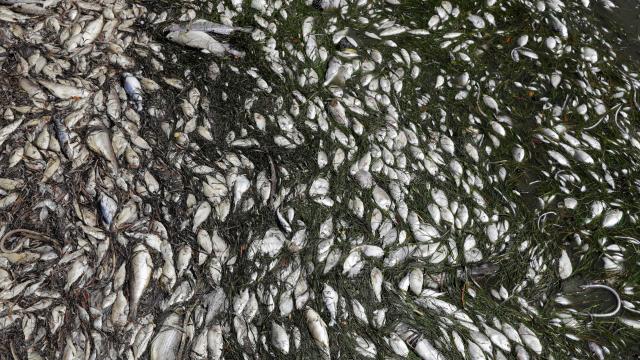The red tide algae bloom that’s plagued Florida’s Gulf Coast for months has now jumped east to the Atlantic. Florida officials are dubbing it an “state’s algae crisis is.
On Monday, officials confirmed the presence of Karenia Brevis, the saltwater algae that smells like a biological weapon and is responsible for fish-killing red tide blooms, off the coast of Palm Beach county. While red tide blooms pop off regularly along Florida’s Gulf Coast, it’s only the eighth time since the 1950s that the offending microbe has been recorded in the state’s Atlantic waters.
“The Florida Fish and Wildlife Conservation Commission (FWC) has detected low to medium concentrations of naturally-occurring red tide in water samples taken Sunday, Sept. 30, off the coast of Palm Beach County,” the agency said in a statement issued Monday. While the state emphasised that concentrations are lower than the most severe blooms observed on the Gulf Coast, beachgoers have already complained about breathing problems and eye irritation.
Red tide blooms initiate about 10-40 miles off Florida’s Gulf coast before getting transported to shore by waves and currents. Once there, the neurotoxins released by K. Brevis produces can sicken humans and kill wildlife. While it’s rare for red tide to jump all the way to the East coast, Richard Stumpf, an oceanographer with the National Oceanic and Atmospheric Administration who tracks red tide via satellite, told Earther it can happen when part of a bloom gets caught up in the Gulf of Mexico loop current, which curves south and east through the Straits of Florida before heading up the Atlantic seaboard.
Stumpf said he spotted signs of the red tide south of Florida near the Marquesas Keys last month, suggesting it had indeed gotten swept into the loop current. From there, he suspects some of the algae made it to the Atlantic, before getting pushed ashore by strong easterly winds over the weekend.
The last time red tide has ridden the loop current all the way east was about a decade ago, Stumpf said, adding that the organism has been recorded as far north as Delaware.
It’s unclear how long red tide will persist along the East coast, although in the past such blooms have been fairly short-lived. Earther has reached out to FWC for additional details on the extent and expected duration of the Atlantic bloom.
It’s just the latest development in a months-long, algae-fuelled assault on Florida’s waterways. The red tide bloom, which started last October, has lingered across more than 161km of Florida’s Gulf coast all summer, triggering hundreds of fish kills and more than 100 manatee deaths, and taking a huge toll on the state’s tourism industry.
Meanwhile, a separate bloom of blue green algae took over Florida’s Lake Okeechobee in June before seeping into the St. Lucie and Caloosahatchee rivers and befouling coastal estuaries all summer long. In September, a spokesperson for Florida’s Department of Environmental Protection told Earther that algae continued to persist on the lake, and that the state had received scattered reports of blooms near Fort Lauderdale and Cape Coral.
The blue green algae mess is closely tied to manmade nutrients seeping into the lake from septic tanks and agricultural runoff. And while scientists aren’t sure exactly why the red tide has been so persistent over the past year, many suspect those same nutrients are helping to sustain it in some way.
With no sign of the algae disappearing anytime soon, the issue is likely to be high on Floridians’ minds as they head to the polls in November.
